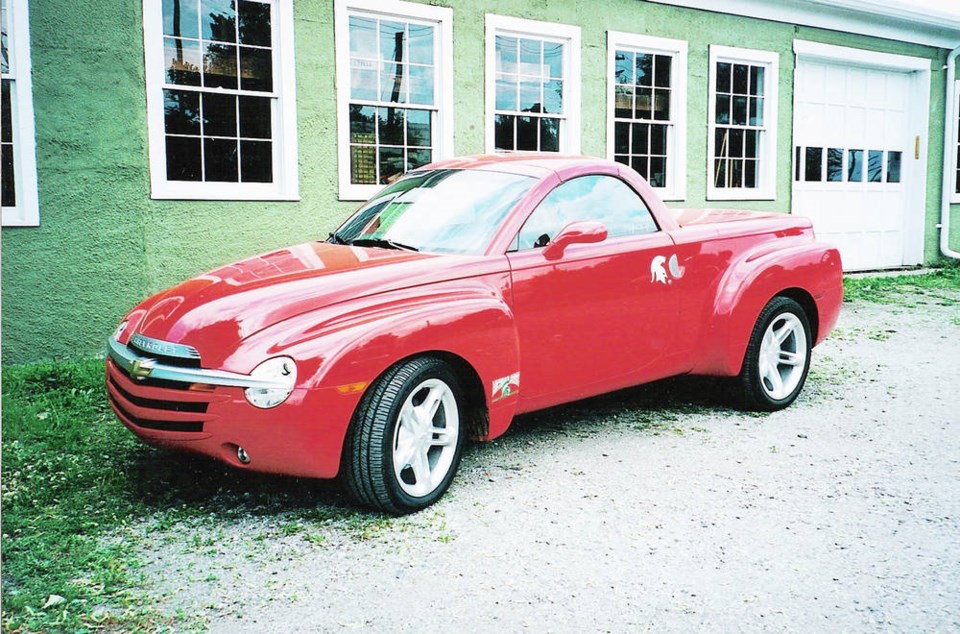Chevrolet called it the SSR (for super sport roadster) because it was marketed as a combination pickup truck and sports roadster. It was introduced in 2003, a reincarnation of the glamorous pickup theme Chevy had inaugurated with the 1955 Cameo Carrier, then refined with the car-based 1959 Chevrolet El Camino, Chevy’s answer to Ford’s Ranchero sedan pickup.
The El Camino and Ranchero were distinguished from pure pickup trucks by having the appearance and driving characteristics of a car with the utility of a cargo box. A difference was that the box was fully integrated with the body rather than the separate cab-and-box configuration of regular pickups.
After several iterations, the original El Camino disappeared in 1987. In reviving and updating the genre with the SSR, Chevrolet deviated by using a shortened and stiffened Chevrolet Trailblazer EXT SUV chassis instead of the passenger-car architecture of the original El Camino. This made it more rugged but heavier at 2,161 kg (4,764 lb).
General Motors showed the SSR as a concept vehicle at the 2000 Detroit Auto Show, where public and media reaction were so positive Chevrolet decided to put it into production.
Built at GM’s Lansing Craft Center, GM’s specialty assembly facility in Lansing, Michigan, it was introduced as a 2003 model. It was chosen as the pace car for the 2003 Indianapolis 500.
While Chevrolet emphasized the SSR’s two passenger roadster theme, its utility box and tailgate truck characteristics were obvious. Although accommodating only 24 cubic feet of cargo and capable of towing just 1,134 kg (2,500 lb), it still qualified it as a truck, albeit with limited capacity.
The somewhat retro look of the SSR was inspired by Chevrolet pickups of the late 1940s and early ’50s in such features as the horizontal grille, prominent fenders and rounded hood. As a novelty feature the single bar grille bisected the headlamps.
The tailgate swung down in normal pickup fashion and the cargo bed could be protected by optional wooden strips. The box was covered by a forward-hinged lid.
There were a couple of factors that set the SSR apart from other sedan-pickups. First, it was a convertible. Second was its piece de resistance: a powered metal folding top.
The top folded in the middle, nestled the two halves together like clamshells, stood them on end and slid them vertically into a bin between the seats and cargo box. A metal tonneau cover gave a smooth and finished appearance. This slick and clever 30-second mechanical choreography never ceased to amaze observers.
Under the rounded hood was a 300 horsepower 5.3 litre overhead valve V-8 with aluminum block and heads sending power to the rear wheels through a four-speed automatic transmission and limited slip differential.
Front suspension was independent by A-arms and coil springs, while the rear was a beam axle with trailing arms and coils. Anti-roll bars were fitted, front and rear and brakes were four-wheel disc with anti-lock. Steering was rack-and-pinion and wheels were a truck-like 19 inch front and 20 inch rear.
Performance was spirited. Car and Driver (9/03) reported zero to 97 km/h (60 mph) in 7.0 seconds and zero to 161 km/h (100 mph) in 20.1 seconds, fast enough to paste your hay bales against the tailgate. Top speed was electronically governed at 203 km/h (126 mph).
In spite of more than adequate acceleration and top speed, hot shoes in the enthusiast media judged it against sports roadsters, as GM wanted, rather than pickups. In this class, C/D declared its performance mediocre and its handling sloppy, pejoratively calling it “a cruiser,” rather than “a curve carver.”
Chevrolet addressed the alleged power shortage for 2005 with a 6.0 litre Corvette C6 V-8 pumping out a stout 390 horsepower backed up by an optional six-speed manual transmission. This gave the SSR sparkling performance, reducing zero to 97 km/h (60 mph) time to the 5.3 second range.
Unfortunately for Chevrolet, sales did not meet expectations. No doubt one of the SSR’s main disadvantages was an initial price in the $70,000 (Cdn) range, perilously close to the Corvette.
Chevrolet realized this was too high and for 2005 brought it down to $60,000, and then for ‘06 to $50,000. In spite of these reductions, SSR sales continued to flag and production ceased in March, 2006, after some 24,000 had been built. GM then closed the Craft Center.
So the SSR faded away like other specialty vehicles such as the Plymouth Prowler and latest Ford Thunderbird. The SSR was neither a very good truck nor a genuine roadster, but its low production and specialty nature bode well for making it a future collectible with all the modern technology.
And that attention- grabbing trick top has to be worth a grand or two.



